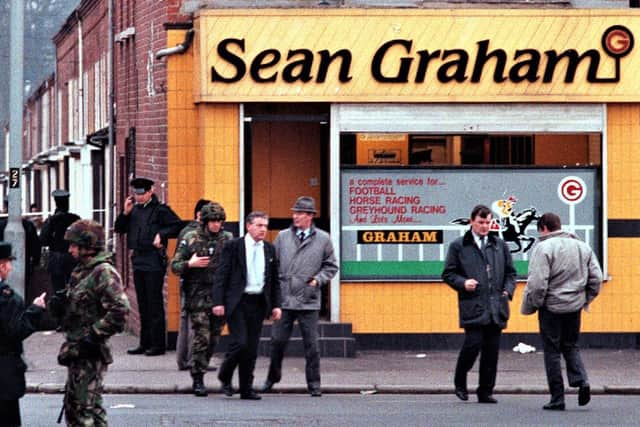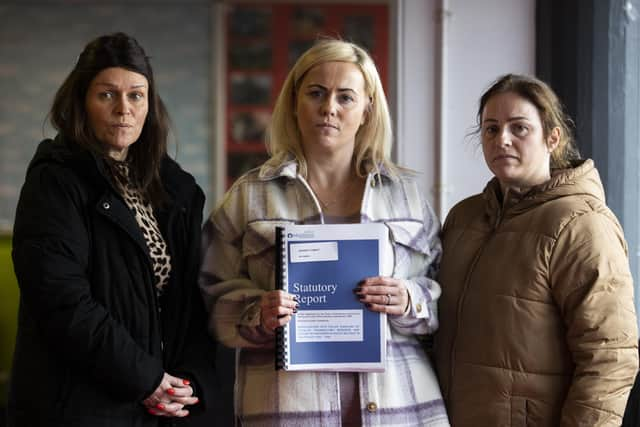Many lives saved and convictions, but report damning for police


The police ombudsman has also found no evidence that any police officers had actively sought to protect informants from arrest or prosecution in relation to a series of murders in south Belfast in the 1990s.
Eleven people were murdered during eight loyalist attacks attributed to the UDA/UFF, including the five Catholics who lost their lives in the Sean Graham bookmakers atrocity on the Ormeau Road in February 1992.
Advertisement
Hide AdAdvertisement
Hide AdTwo of men widely believed to have been involved in either planning or carrying out the attack on the bookmakers were shot dead by the IRA in 1994.


A number of other loyalists have been convicted of possessing the weapons used by the gunmen and of other terrorist-related offences.
In her 344-page report, Ombudsman Marie Anderson also stated: “This investigation has found no evidence that police were in possession of intelligence which if acted on, could have prevented any of the attacks”.
However, the report is highly critical of police record keeping, intelligence gathering and how it was disseminated, the oversight of informants and the control of weapons.
Advertisement
Hide AdAdvertisement
Hide AdMs Anderson said she was “deeply concerned” by the scale and scope of police failings she had uncovered during her investigation – and said he had identified what she called “collusive behaviours”.
Among her damning findings, Mrs Anderson said Royal Ulster Constabulary (RUC) files relating to the bookmakers massacre had been deliberately destroyed.
The ombudsman also described as “totally unacceptable” the use by RUC Special Branch of informants who had themselves been involved in murders.
While she found no evidence that police had received information that would have allowed them to prevent any of the attacks, the ombudsman questioned why no such intelligence was received, given that Special Branch had a network of informants within the UDA/UFF.
Advertisement
Hide AdAdvertisement
Hide AdA Court of Appeal judgment in 2020 has limited the scope of the ombudsman to accuse former officers of the criminal offence of collusion with paramilitaries.
Acknowledging this limitation, Ms Anderson said she had identified conduct within the RUC that amounted to “collusive behaviours”.
She said the long-held concerns of bereaved families and survivors about RUC conduct, including complaints of collusion with paramilitaries, were “legitimate and justified”.
Ms Anderson said “collusive behaviours” identified in her report included: intelligence and surveillance failings which led to loyalist paramilitaries obtaining military grade weaponry in a 1987 arms importation; a failure to warn two men of threats to their lives, and a failure to retain records and the deliberate destruction of files relating to the attack at Sean Graham bookmakers.
Advertisement
Hide AdAdvertisement
Hide AdThe murders and attempted murders were carried out between 1990 and 1998. All the victims were Catholic.
Christy Doherty, Jack Duffin, Peter Magee, Willie McManus and 15-year-old James Kennedy all died in the betting shop attack. Several others were badly injured.
The report also covered the murders of Harry Conlon and Aidan Wallace in 1991, Michael Gilbride in 1992, Martin Moran in 1993, Theresa Clinton in 1994 and Larry Brennan in 1998.
It also examined the attempted murder of Samuel Caskey in 1990.
Advertisement
Hide AdAdvertisement
Hide AdThe ombudsman said the RUC response to a significant escalation in UDA/UFF activity in the early 1990s led to it recruiting “high-risk” informants suspected of involvement in previous murders.
She said Special Branch failed to consider the implications of this strategy or to properly manage the informers.
In regard to the Sean Graham attack, the report said there was a delay in recovering and forensically examining the car; blood found on the coat of a suspect was not tested against the blood of the dead and injured; and a man suspected of having moved weapons was not arrested.
The ombudsman said there was also no evidence police took steps to test an aspect of a suspect’s alibi.
Advertisement
Hide AdAdvertisement
Hide AdThe report also identified concerns about police returning of both “deactivated” and live weapons to a loyalist informant.
This was despite police being aware of intelligence that loyalists had the ability to make deactivated weapons operational again.
One weapon – a deactivated Browning pistol – was subsequently reactivated and used in the murder of Mr Wallace and in the Sean Graham bookmakers shooting.
The ombudsman also criticised a failure by Special Branch to issue threat warnings to two men after intelligence indicated their lives were in danger.
Advertisement
Hide AdAdvertisement
Hide AdThe threats related to Mr Caskey prior to the murder attempt on him in 1990 and to Jim Clinton, whose wife Theresa was killed in the attack on their home in 1994.
Mrs Anderson said the failure to warn both men contravened police guidance for the issuing of threat warnings.
“I am of the view that this serious omission constitutes collusive behaviour,” she said.
The ombudsman also identified instances of weapons connected to murder inquiries being disposed of in “inappropriate” ways, as well as evidence of records being routinely destroyed by the police.
Advertisement
Hide AdAdvertisement
Hide AdShe said a decision to donate the VZ58 rifle used in the bookmakers attack to the Imperial War Museum had caused “understandable distress to the victims, survivors and their families”.
Mrs Anderson also criticised the fact that a Browning pistol used during the bookmakers attack and in the murder of Mr Wallace had been returned to the military. The gun had been stolen from the UDR by loyalists in January 1989.
She said the “routine” destruction of records by the RUC’s Tasking and Co-ordinating Group, including records of covert operations and the intelligence underpinning them, had “obstructed examination of accountability”.
She referred in particular to the decision to destroy records relating to the bookmakers shooting.
Advertisement
Hide AdAdvertisement
Hide Ad“As a consequence, there are no records of the decision/decisions not to recover the weapons and other items likely to have been used in the attack, some of which were never recovered, or not recovered until months later,” she said.
“Similarly, there are no records of the decision not to make early arrests of those in possession of these items.
“The recovery of this material and these arrests could well have proven key to the detection of these crimes.”
The ombudsman also looked at a ninth loyalist attack – the murder of John O’Hara in 1991.
Advertisement
Hide AdAdvertisement
Hide AdHowever, details of that investigation are not included in the published report due to ongoing criminal proceedings linked to that crime.
• Unlike many terrorist atrocities in Northern Ireland, the police response to the murder of five people at the Ormeau Road bookmakers resulted in arrests, the recovery of weapons and criminal charges.
Within two weeks of the attack, police intelligence led officers to a house in the Tullycarnet estate on the outskirts of east Belfast.
Mark Rice was arrested at the property after a search revealed the Czech-made VZ58 assault rifle used in the bookmakers shooting.
Advertisement
Hide AdAdvertisement
Hide AdA quantity of ammunition, a shotgun and a range of terrorist paraphernalia were also found.
According to a Relatives for Justice report, “the fingerprints of three other loyalists who frequented Tullycarnet estate were found on the documents and they too were subsequently charged”.
Three people were sentenced for possession of documents likely to be of use to terrorists.
Mark Rice was charged by police with multiple murders, attempted murder and aiding and abetting but was ultimately acquitted by a court on all of those charges.
Advertisement
Hide AdAdvertisement
Hide AdHowever, in November 1993 he was convicted of possession of the rifle used in the bookmakers murders and sentenced to 20 years.
Another man linked to the atrocity through one of the firearms used was Dennis Paisley from Lisburn.
Paisley was arrested and a Browning 9mm pistol recovered within months of the murders when specialist police officers stopped a van at Ballyskeagh on the outskirts of the city.
A second gun, an old Webley revolver, was also found in the vehicle.
Advertisement
Hide AdAdvertisement
Hide AdThe passenger in the van, Andrew Webb, was also arrested at the scene and taken into custody. In May 1992, both Paisley and Webb were charged with possession of the two handguns and ammunition.
The following March, Paisley was handed a seven-year sentence while Webb was found not guilty.
One of the main suspects in the murders was Raymond Elder. Elder was arrested and charged but the charges were eventually dropped by the prosecution service.
Another man suspected of planning the attack, Joe Bratty, had an alibi for the time of the murders.
Advertisement
Hide AdAdvertisement
Hide AdBratty was shot dead by the IRA alongside Elder on the Ormeau Road in 1994, just weeks before the IRA ceasefire.
Other arrests were made in connection with the purchase of the vehicle used as a getaway car by the loyalist terrorists, but no charges were forthcoming.
——— ———
A message from the Editor:
Thank you for reading this story on our website. While I have your attention, I also have an important request to make of you.
With the coronavirus lockdowns having had a major impact on many of our advertisers — and consequently the revenue we receive — we are more reliant than ever on you taking out a digital subscription.
Advertisement
Hide AdAdvertisement
Hide AdSubscribe to newsletter.co.uk and enjoy unlimited access to the best Northern Ireland and UK news and information online and on our app. With a digital subscription, you can read more than 5 articles, see fewer ads, enjoy faster load times, and get access to exclusive newsletters and content.
Visit https://www.newsletter.co.uk/subscriptionsnow to sign up.
Our journalism costs money and we rely on advertising, print and digital revenues to help to support them. By supporting us, we are able to support you in providing trusted, fact-checked content for this website.
Ben Lowry, Editor